YAMAHA YZF600 2001 Owners Manual
Manufacturer: YAMAHA, Model Year: 2001, Model line: YZF600, Model: YAMAHA YZF600 2001Pages: 114, PDF Size: 12.39 MB
Page 91 of 114
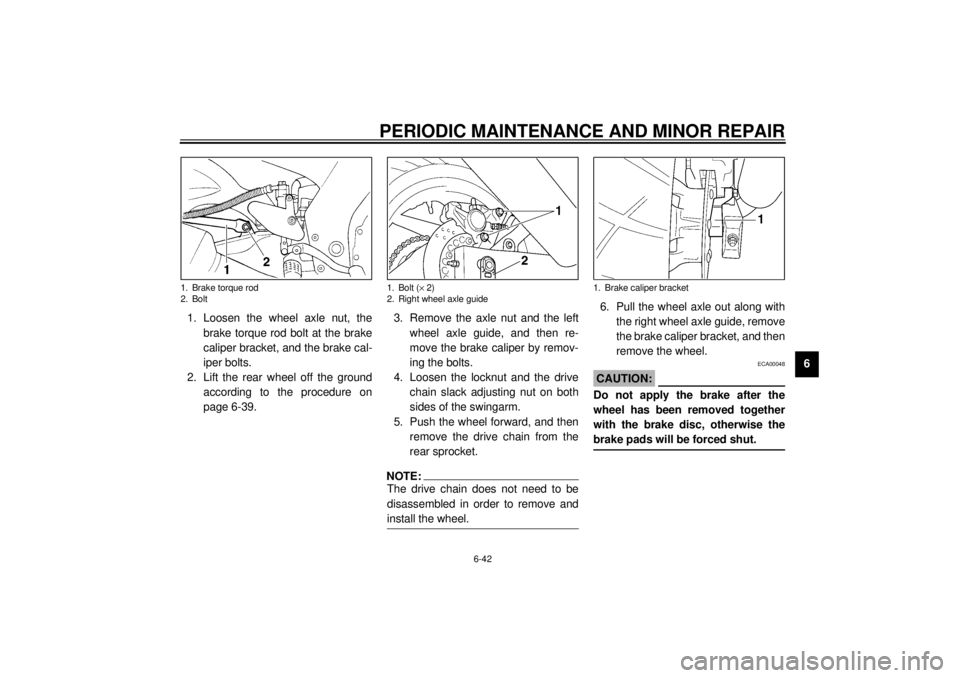
PERIODIC MAINTENANCE AND MINOR REPAIR
6-42
6 1. Loosen the wheel axle nut, the
brake torque rod bolt at the brake
caliper bracket, and the brake cal-
iper bolts.
2. Lift the rear wheel off the ground
according to the procedure on
page 6-39.3. Remove the axle nut and the left
wheel axle guide, and then re-
move the brake caliper by remov-
ing the bolts.
4. Loosen the locknut and the drive
chain slack adjusting nut on both
sides of the swingarm.
5. Push the wheel forward, and then
remove the drive chain from the
rear sprocket.
NOTE:_ The drive chain does not need to be
disassembled in order to remove and
install the wheel. _
6. Pull the wheel axle out along with
the right wheel axle guide, remove
the brake caliper bracket, and then
remove the wheel.
ECA00048
CAUTION:_ Do not apply the brake after the
wheel has been removed together
with the brake disc, otherwise the
brake pads will be forced shut. _
1. Brake torque rod
2. Bolt
1. Bolt (´ 2)
2. Right wheel axle guide
1. Brake caliper bracket
E_4tv.book Page 42 Wednesday, October 4, 2000 2:15 PM
Page 92 of 114
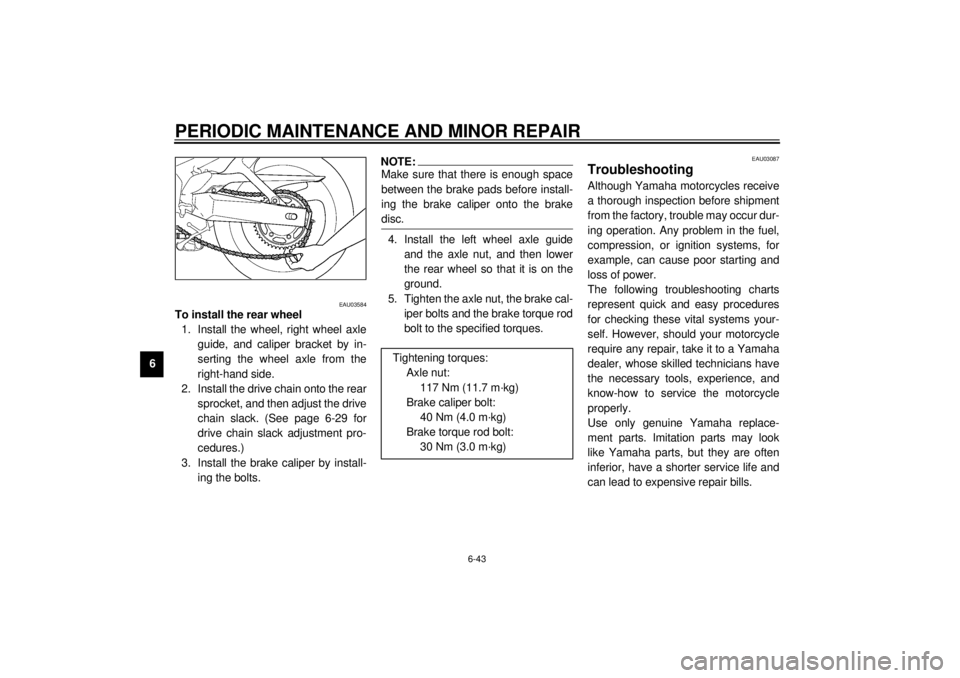
PERIODIC MAINTENANCE AND MINOR REPAIR
6-43
6
EAU03584
To install the rear wheel
1. Install the wheel, right wheel axle
guide, and caliper bracket by in-
serting the wheel axle from the
right-hand side.
2. Install the drive chain onto the rear
sprocket, and then adjust the drive
chain slack. (See page 6-29 for
drive chain slack adjustment pro-
cedures.)
3. Install the brake caliper by install-
ing the bolts.
NOTE:_ Make sure that there is enough space
between the brake pads before install-
ing the brake caliper onto the brake
disc. _4. Install the left wheel axle guide
and the axle nut, and then lower
the rear wheel so that it is on the
ground.
5. Tighten the axle nut, the brake cal-
iper bolts and the brake torque rod
bolt to the specified torques.
EAU03087
Troubleshooting Although Yamaha motorcycles receive
a thorough inspection before shipment
from the factory, trouble may occur dur-
ing operation. Any problem in the fuel,
compression, or ignition systems, for
example, can cause poor starting and
loss of power.
The following troubleshooting charts
represent quick and easy procedures
for checking these vital systems your-
self. However, should your motorcycle
require any repair, take it to a Yamaha
dealer, whose skilled technicians have
the necessary tools, experience, and
know-how to service the motorcycle
properly.
Use only genuine Yamaha replace-
ment parts. Imitation parts may look
like Yamaha parts, but they are often
inferior, have a shorter service life and
can lead to expensive repair bills.
Tightening torques:
Axle nut:
117 Nm (11.7 m·kg)
Brake caliper bolt:
40 Nm (4.0 m·kg)
Brake torque rod bolt:
30 Nm (3.0 m·kg)
E_4tv.book Page 43 Wednesday, October 4, 2000 2:15 PM
Page 93 of 114
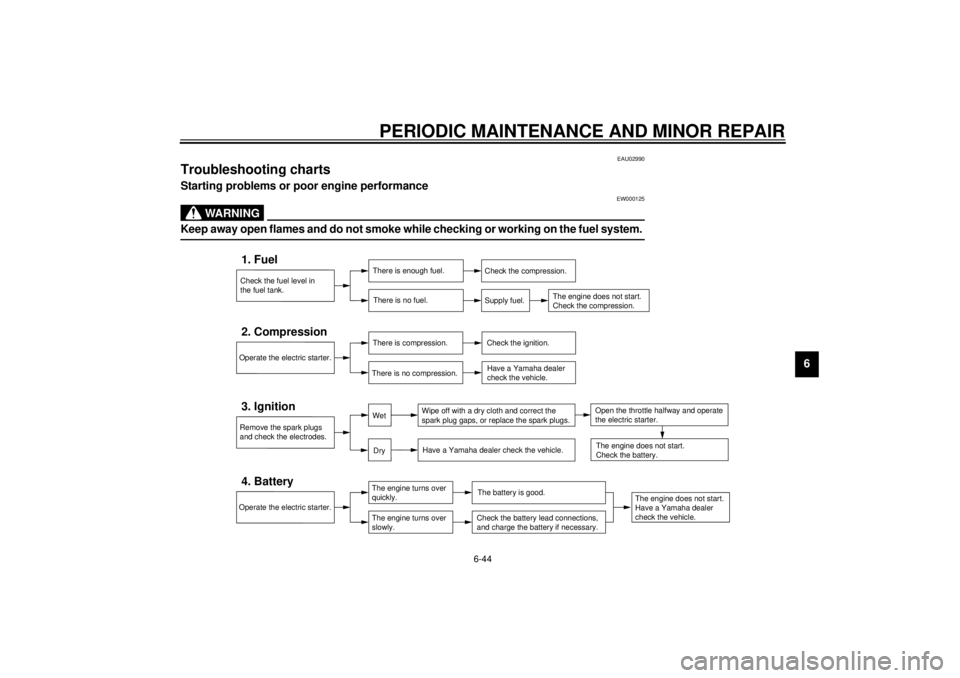
PERIODIC MAINTENANCE AND MINOR REPAIR
6-44
6
EAU02990
Troubleshooting charts Starting problems or poor engine performance
EW000125
WARNING
_ Keep away open flames and do not smoke while checking or working on the fuel system. _
Check the fuel level in
the fuel tank.1. Fuel
There is enough fuel.
There is no fuel.
Check the compression.
Supply fuel.
The engine does not start.
Check the compression.
Operate the electric starter.2. Compression
There is compression.
There is no compression.
Check the ignition.
Have a Yamaha dealer
check the vehicle.
Remove the spark plugs
and check the electrodes.3. Ignition
Wipe off with a dry cloth and correct the
spark plug gaps, or replace the spark plugs.
Have a Yamaha dealer check the vehicle.
The engine does not start.
Have a Yamaha dealer
check the vehicle.
Operate the electric starter.4. Battery
The engine turns over
quickly.
The engine turns over
slowly.DryWet
The engine does not start.
Check the battery.Open the throttle halfway and operate
the electric starter.
The battery is good.Check the battery lead connections,
and charge the battery if necessary.
E_4tv.book Page 44 Wednesday, October 4, 2000 2:15 PM
Page 94 of 114
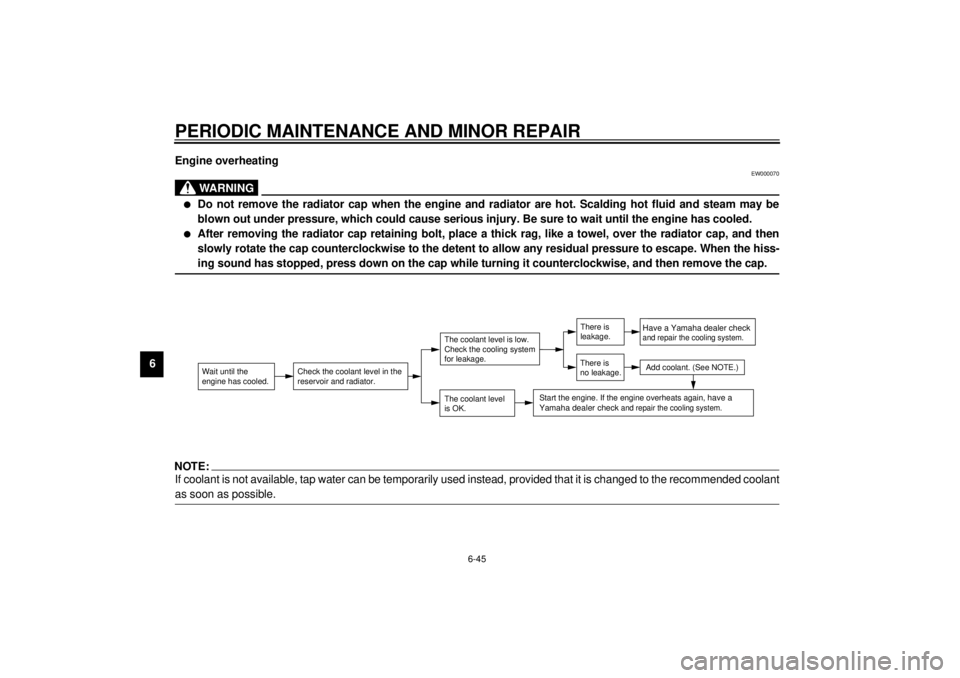
PERIODIC MAINTENANCE AND MINOR REPAIR
6-45
6Engine overheating
EW000070
WARNING
_ l
Do not remove the radiator cap when the engine and radiator are hot. Scalding hot fluid and steam may be
blown out under pressure, which could cause serious injury. Be sure to wait until the engine has cooled.
l
After removing the radiator cap retaining bolt, place a thick rag, like a towel, over the radiator cap, and then
slowly rotate the cap counterclockwise to the detent to allow any residual pressure to escape. When the hiss-
ing sound has stopped, press down on the cap while turning it counterclockwise, and then remove the cap.
_NOTE:_ If coolant is not available, tap water can be temporarily used instead, provided that it is changed to the recommended coolant
as soon as possible. _
Wait until the
engine has cooled.
Check the coolant level in the
reservoir and radiator.
The coolant level
is OK.The coolant level is low.
Check the cooling system
for leakage.
Have a Yamaha dealer checkand repair the cooling system.Add coolant. (See NOTE.)
Start the engine. If the engine overheats again,
have a
Yamaha dealer check
and repair the cooling system.
There is
leakage.
There is
no leakage.
E_4tv.book Page 45 Wednesday, October 4, 2000 2:15 PM
Page 95 of 114
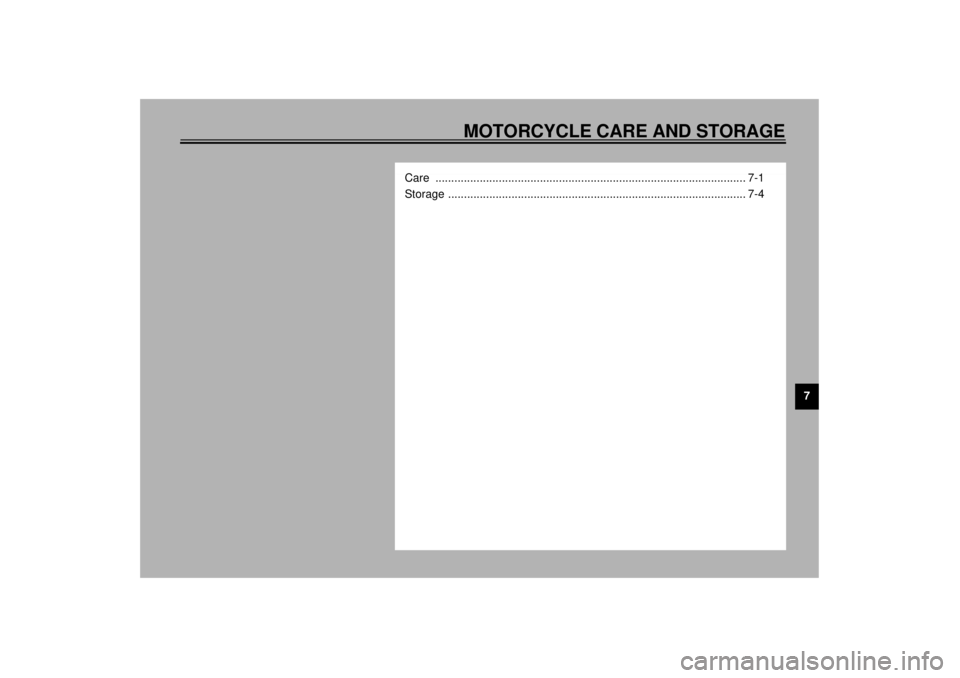
MOTORCYCLE CARE AND STORAGE
7
Care .................................................................................................. 7-1
Storage .............................................................................................. 7-4
E_4tv.book Page 1 Wednesday, October 4, 2000 2:15 PM
Page 96 of 114
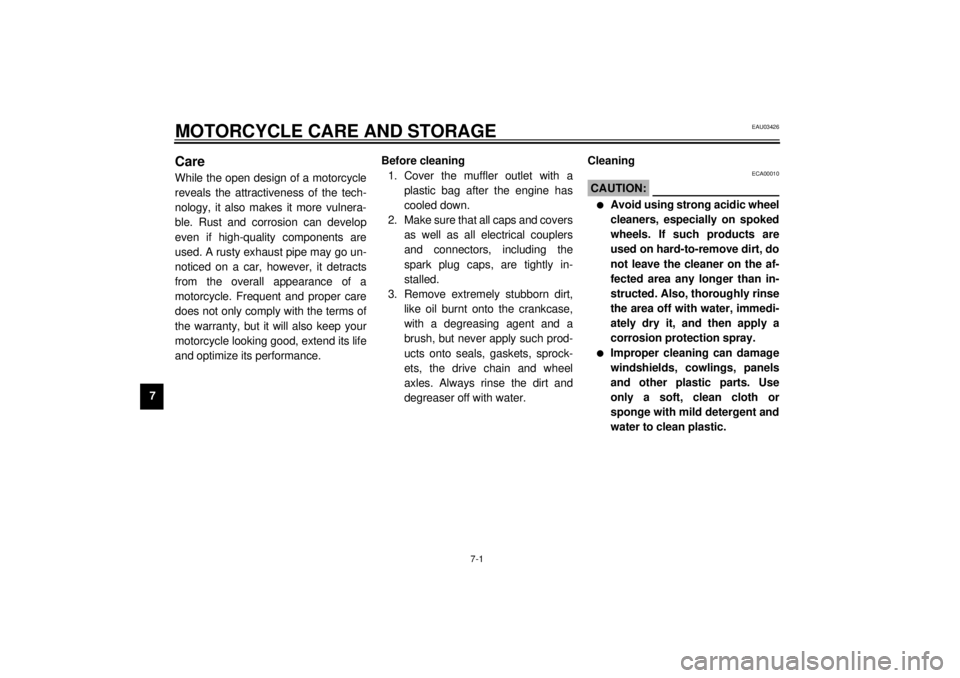
7-1
7
EAU03426
7-MOTORCYCLE CARE AND STORAGECare While the open design of a motorcycle
reveals the attractiveness of the tech-
nology, it also makes it more vulnera-
ble. Rust and corrosion can develop
even if high-quality components are
used. A rusty exhaust pipe may go un-
noticed on a car, however, it detracts
from the overall appearance of a
motorcycle. Frequent and proper care
does not only comply with the terms of
the warranty, but it will also keep your
motorcycle looking good, extend its life
and optimize its performance.Before cleaning
1. Cover the muffler outlet with a
plastic bag after the engine has
cooled down.
2. Make sure that all caps and covers
as well as all electrical couplers
and connectors, including the
spark plug caps, are tightly in-
stalled.
3. Remove extremely stubborn dirt,
like oil burnt onto the crankcase,
with a degreasing agent and a
brush, but never apply such prod-
ucts onto seals, gaskets, sprock-
ets, the drive chain and wheel
axles. Always rinse the dirt and
degreaser off with water.Cleaning
ECA00010
CAUTION:_ l
Avoid using strong acidic wheel
cleaners, especially on spoked
wheels. If such products are
used on hard-to-remove dirt, do
not leave the cleaner on the af-
fected area any longer than in-
structed. Also, thoroughly rinse
the area off with water, immedi-
ately dry it, and then apply a
corrosion protection spray.
l
Improper cleaning can damage
windshields, cowlings, panels
and other plastic parts. Use
only a soft, clean cloth or
sponge with mild detergent and
water to clean plastic.
E_4tv.book Page 1 Wednesday, October 4, 2000 2:15 PM
Page 97 of 114
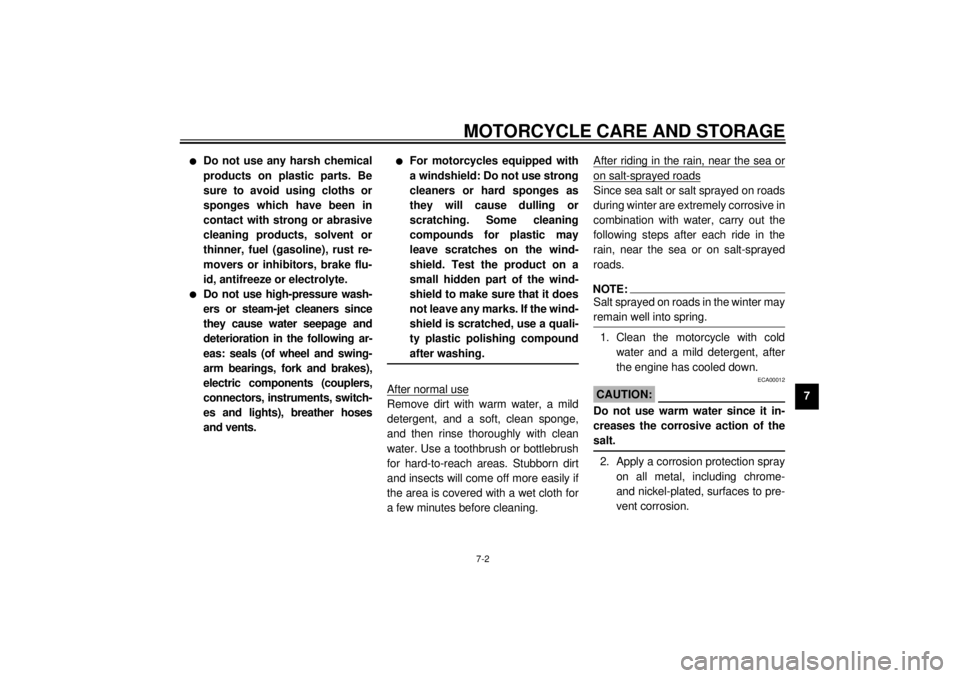
MOTORCYCLE CARE AND STORAGE
7-2
7
l
Do not use any harsh chemical
products on plastic parts. Be
sure to avoid using cloths or
sponges which have been in
contact with strong or abrasive
cleaning products, solvent or
thinner, fuel (gasoline), rust re-
movers or inhibitors, brake flu-
id, antifreeze or electrolyte.
l
Do not use high-pressure wash-
ers or steam-jet cleaners since
they cause water seepage and
deterioration in the following ar-
eas: seals (of wheel and swing-
arm bearings, fork and brakes),
electric components (couplers,
connectors, instruments, switch-
es and lights), breather hoses
and vents.
l
For motorcycles equipped with
a windshield: Do not use strong
cleaners or hard sponges as
they will cause dulling or
scratching. Some cleaning
compounds for plastic may
leave scratches on the wind-
shield. Test the product on a
small hidden part of the wind-
shield to make sure that it does
not leave any marks. If the wind-
shield is scratched, use a quali-
ty plastic polishing compound
after washing.
_After normal useRemove dirt with warm water, a mild
detergent, and a soft, clean sponge,
and then rinse thoroughly with clean
water. Use a toothbrush or bottlebrush
for hard-to-reach areas. Stubborn dirt
and insects will come off more easily if
the area is covered with a wet cloth for
a few minutes before cleaning.After riding in the rain, near the sea or
on salt-sprayed roadsSince sea salt or salt sprayed on roads
during winter are extremely corrosive in
combination with water, carry out the
following steps after each ride in the
rain, near the sea or on salt-sprayed
roads.NOTE:_ Salt sprayed on roads in the winter may
remain well into spring. _1. Clean the motorcycle with cold
water and a mild detergent, after
the engine has cooled down.
ECA00012
CAUTION:_ Do not use warm water since it in-
creases the corrosive action of the
salt. _2. Apply a corrosion protection spray
on all metal, including chrome-
and nickel-plated, surfaces to pre-
vent corrosion.
E_4tv.book Page 2 Wednesday, October 4, 2000 2:15 PM
Page 98 of 114
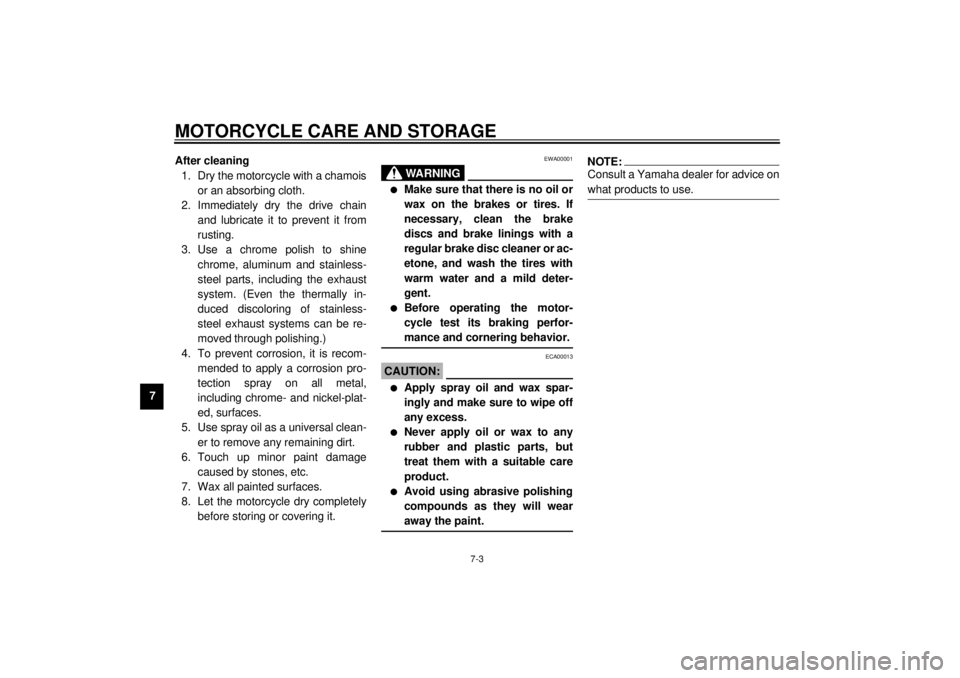
MOTORCYCLE CARE AND STORAGE
7-3
7After cleaning
1. Dry the motorcycle with a chamois
or an absorbing cloth.
2. Immediately dry the drive chain
and lubricate it to prevent it from
rusting.
3. Use a chrome polish to shine
chrome, aluminum and stainless-
steel parts, including the exhaust
system. (Even the thermally in-
duced discoloring of stainless-
steel exhaust systems can be re-
moved through polishing.)
4. To prevent corrosion, it is recom-
mended to apply a corrosion pro-
tection spray on all metal,
including chrome- and nickel-plat-
ed, surfaces.
5. Use spray oil as a universal clean-
er to remove any remaining dirt.
6. Touch up minor paint damage
caused by stones, etc.
7. Wax all painted surfaces.
8. Let the motorcycle dry completely
before storing or covering it.
EWA00001
WARNING
_ l
Make sure that there is no oil or
wax on the brakes or tires. If
necessary, clean the brake
discs and brake linings with a
regular brake disc cleaner or ac-
etone, and wash the tires with
warm water and a mild deter-
gent.
l
Before operating the motor-
cycle test its braking perfor-
mance and cornering behavior.
_
ECA00013
CAUTION:_ l
Apply spray oil and wax spar-
ingly and make sure to wipe off
any excess.
l
Never apply oil or wax to any
rubber and plastic parts, but
treat them with a suitable care
product.
l
Avoid using abrasive polishing
compounds as they will wear
away the paint.
_
NOTE:_ Consult a Yamaha dealer for advice on
what products to use. _
E_4tv.book Page 3 Wednesday, October 4, 2000 2:15 PM
Page 99 of 114

MOTORCYCLE CARE AND STORAGE
7-4
7
Storage Short-term
Always store your motorcycle in a cool,
dry place and, if necessary, protect it
against dust with a porous cover.
ECA00014
CAUTION:_ l
Storing the motorcycle in a
poorly ventilated room or cover-
ing it with a tarp, while it is still
wet, will allow water and humid-
ity to seep in and cause rust.
l
To prevent corrosion, avoid
damp cellars, stables (because
of the presence of ammonia)
and areas where strong chemi-
cals are stored.
_
Long-term
Before storing your motorcycle for sev-
eral months:
1. Follow all the instructions in the
“Care” section of this chapter.
2. For motorcycles equipped with a
fuel cock that has an “OFF” posi-
tion: Turn the fuel cock lever to
“OFF”.
3. Drain the carburetor float chamber
by loosening the drain bolt; this will
prevent fuel deposits from building
up. Pour the drained fuel into the
fuel tank.
4. Fill up the fuel tank and add fuel
stabilizer (if available) to prevent
the fuel tank from rusting and the
fuel from deteriorating.
5. Perform the following steps to pro-
tect the cylinders, piston rings, etc.
from corrosion.a. Remove the spark plug caps and
spark plugs.
b. Pour a teaspoonful of engine oil
into each spark plug bore.
c. Install the spark plug caps onto the
spark plugs, and then place the
spark plugs on the cylinder head
so that the electrodes are ground-
ed. (This will limit sparking during
the next step.)
d. Turn the engine over several times
with the starter. (This will coat the
cylinder walls with oil.)
e. Remove the spark plug caps from
the spark plugs, and then install
the spark plugs and the spark plug
caps.
EWA00003
WARNING
_ To prevent damage or injury from
sparking, make sure to ground the
spark plug electrodes while turning
the engine over. _
E_4tv.book Page 4 Wednesday, October 4, 2000 2:15 PM
Page 100 of 114
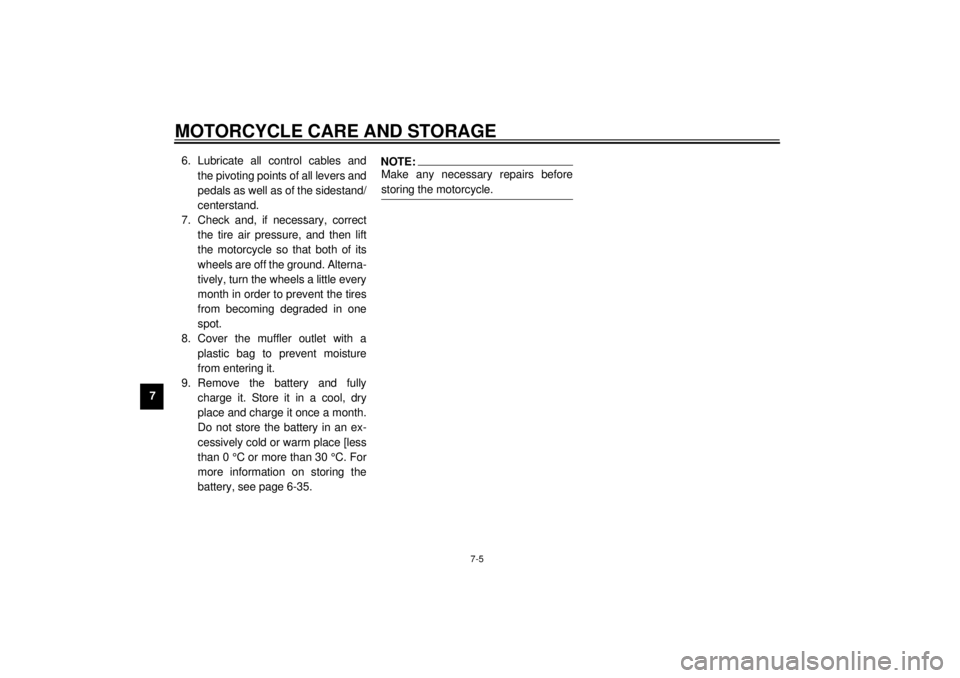
MOTORCYCLE CARE AND STORAGE
7-5
76. Lubricate all control cables and
the pivoting points of all levers and
pedals as well as of the sidestand/
centerstand.
7. Check and, if necessary, correct
the tire air pressure, and then lift
the motorcycle so that both of its
wheels are off the ground. Alterna-
tively, turn the wheels a little every
month in order to prevent the tires
from becoming degraded in one
spot.
8. Cover the muffler outlet with a
plastic bag to prevent moisture
from entering it.
9. Remove the battery and fully
charge it. Store it in a cool, dry
place and charge it once a month.
Do not store the battery in an ex-
cessively cold or warm place [less
than 0 °C or more than 30 °C. For
more information on storing the
battery, see page 6-35.
NOTE:_ Make any necessary repairs before
storing the motorcycle. _
E_4tv.book Page 5 Wednesday, October 4, 2000 2:15 PM